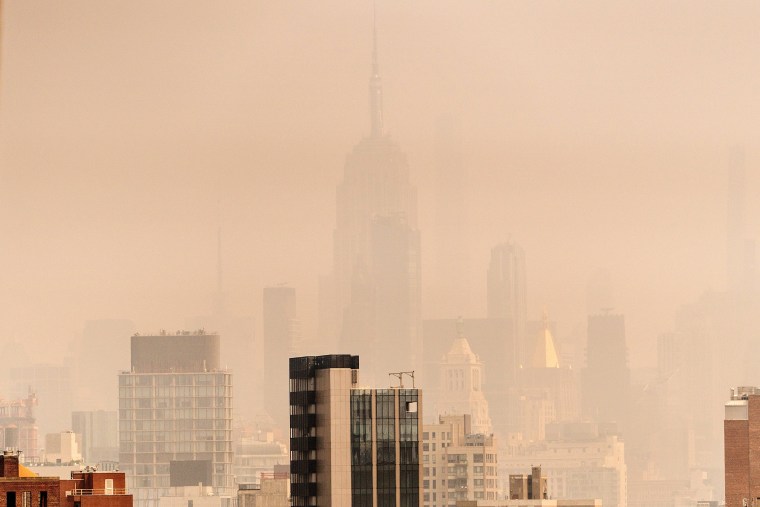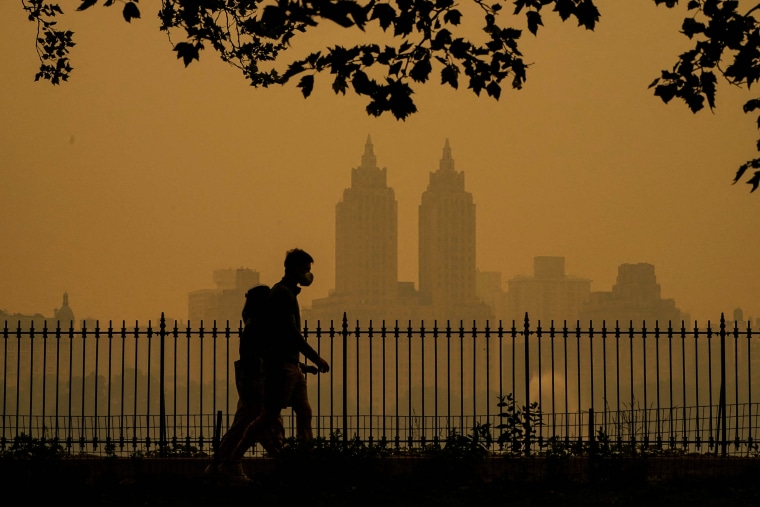It’s the summer of smoke with no end in sight.
Canadian wildfires sent so much smoke into U.S. cities in June that this season already qualifies as the worst smoke season in recent memory, according to an analysis of smoke exposure per person across the country recently completed by Stanford University researchers.
“This is the worst year since 2006,” said Marshall Burke, an associate professor of Earth system science at Stanford, who added that it was a remarkable measure because the “wildfire season we’re used to hasn’t even started yet.”
The June haze events were a wake-up call to communities unprepared for wildfire smoke, delaying hundreds of flights on the East Coast, shuttering outdoor events like baseball games and increasing hospital visits for ailments like asthma.
But they’re likely just the start of the nation’s smoke troubles this season, according to wildfire experts, who expect Canada’s fires to belch smoke all summer and who also see conditions brewing for wildfire in parts of the U.S., including in the Pacific Northwest and the upper Midwest.
Canada reported about 880 fires burning as of Wednesday morning. More than half of those fires are considered “out of control,” according to the Canadian Interagency Forest Fire Centre. Long-term forecasts suggest the majority of the country will have above-average fire risk through September.
Many of the largest fires are expected to burn all summer and occasionally send a blast of smoke down south as atmospheric patterns shift.

“There will be intermittent bursts of fire activity,” said Robert Gray, a Canadian wildfire ecologist based in Chilliwack, British Columbia. “We can expect the U.S. will see more smoke in the next couple of months.”
He said little can stall the wildfires burning in Canada’s northern boreal forests.
“It’s all flat. This time of year, you’ve got 22, 23 hours of daylight and wind. And they’re just giant, wind-driven fires, and they burn over lakes and around lakes,” Gray said. “There’s not a lot of things there to slow them down, which is why they get so big.”
He said he often fields questions from people in the U.S. about why the fires can’t simply be snuffed out by wildland firefighters.
Some of the largest fires are burning in areas without roads Gray said. Fires can advance by 5-10 miles in a day. With so many massive fires burning in close proximity, it’s unsafe to put firefighters in between the blazes.
“Just go put the fires out — it doesn’t work that way,” he said. “Welcome to climate change.”
Wildfire season in the U.S. could kick off in earnest this month and produce some local smoke, too. The latest National Interagency Fire Center forecast shows “above normal” fire potential in the U.S. Pacific Northwest and in the upper Midwest until summer’s over.
“It could be a season that starts this year from April, all the way through to September, and that is unheard of for us,” said Keith Murphy, a fire management specialist with the Michigan State Department of Natural Resources. “I was on fires in May that looked like the dog days of August.”
He said the effects of Canadian wildfire smoke forced his agency to pull back on performing prescribed burns, a practice in which fires are set intentionally during stretches of safe weather to better prepare the landscape for more gentle wildfires.
“It’s been really rough here in the Upper Peninsula. It’s affecting the elderly, children, some asthmatic folks. Their lungs are getting irritated, eyes are getting irritated, it was just that thick,” Murphy said. “We haven’t even entertained thoughts of prescribed burning because of the smoke concerns in Canada. People are probably fed up enough with all the smoke and we don’t want to add to that.”
